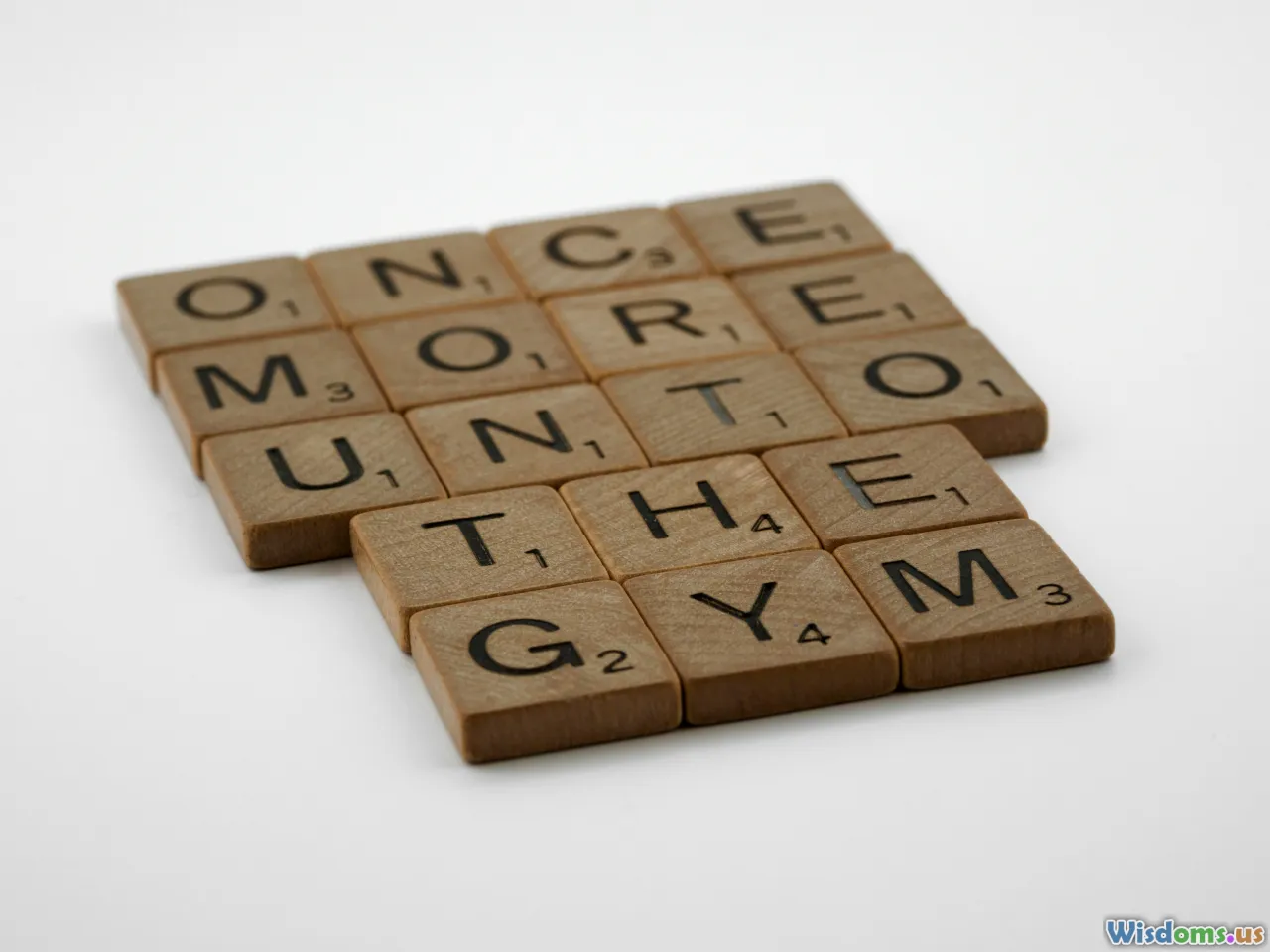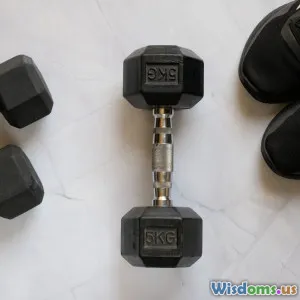
Should You Train Core Muscles Every Day or Alternate
19 min read Explore whether daily core muscle training or alternating rest days yields better results for strength, definition, and injury prevention. (0 Reviews)
Should You Train Core Muscles Every Day or Alternate?
The pursuit of a strong core has become central in fitness routines worldwide, but a common debate remains: Should you train your core muscles every day or on alternating days? The answer isn't as straightforward as you might think, hinging on science, individual goals, and the nuances of muscle recovery. This comprehensive guide will dissect both sides, provide expert strategies, and help you sculpt a core routine that fits your body and lifestyle.
Understanding Core Muscles and Their Role

Your core is far more than just your abdominal muscles. This complex group includes the rectus abdominis (the famous “six-pack”), obliques, transverse abdominis, erector spinae, and the muscles deep in your hips. They work together to stabilize the spine, protect internal organs, and transfer force throughout your body.
Why Core Strength Matters:
- Posture: Maintains proper alignment, reducing risk of chronic pain.
- Injury Prevention: A stable core guards the back and hips during daily activities and athletic pursuits.
- Performance: Whether in athletics or simply getting out of bed, the core is central to almost every movement.
Example: A 2019 study in the Journal of Strength and Conditioning Research revealed athletes with stronger core muscles perform better in sprinting, jumping, and agility tests compared to those who neglect core training. This versatility shows why cores are trained in both rehabilitation clinics and pro athlete facilities alike.
Mechanisms of Muscle Growth and Recovery

Muscles—including those in your core—don’t grow while you exercise; they grow while you rest. Training causes tiny tears in muscle fibers, and proper recovery allows these fibers to heal and strengthen.
How Muscles Adapt:
- Training: Mechanical tension, metabolic stress, and muscle damage initiate adaptation processes.
- Recovery: Protein synthesis, fueled by good nutrition and sleep, rebuilds tissue.
Key Fact: For most muscle groups, the American College of Sports Medicine (ACSM) recommends 48 hours' rest between intense sessions to optimize recovery and growth. But here’s where cores stand apart: they’re involved in nearly every movement and thus often recover more rapidly than larger muscle groups like legs or back.
Arguments for Daily Core Training

1. High Endurance and Recovery Capacity
Core muscles are actively engaged throughout the day—when you stand, walk, or even breathe. This endurance capacity leads some trainers and athletes to advocate daily training.
Case Example: Gymnasts and dancers often include daily core routines, coupled with some of the world's strongest, functionally-trained midsections.
Pro: Frequent training can reinforce motor patterns, leading to better stability and posture.
2. Convenience and Consistency
Working your core every day can instill discipline and prevent procrastination. Short, daily abs routines—often seen in 30-day ab challenges—help many people stay on track.
Tip: If your sessions are brief (5–10 minutes of low-intensity, form-focused work), there’s minimal risk of overtraining for most people.
3. Focus on Variety and Function
Daily routines can alternate muscle emphasis: e.g., focusing on anti-rotation on Monday and lower abs on Tuesday. This variety can prevent imbalances and boredom.
Sample Schedule:
- Monday: Planks and anti-extension drills
- Tuesday: Russian twists and side planks (obliques focus)
- Wednesday: Dynamic leg raises (lower ab strength)
When Daily Training is Unsafe: If each session is high intensity or fatigue becomes overwhelming, you're likely impeding progress instead of furthering it—something we’ll analyze below.
Science-Backed Case for Alternating Days

1. Preventing Overtraining and Injury
Core muscles, like any body part, are prone to overuse injuries—especially if your workouts are long, intense, or compounded by poor recovery habits.
Concern: Overworked abs can lead to muscle strains, lower back pain, and even posture problems if stabilizers are fatigued.
Research Spotlight: A 2017 Frontiers in Physiology review concluded that high-frequency training with insufficient recovery increases levels of the stress hormone cortisol, leading to stagnated muscle gains and, paradoxically, decreased core strength.
2. Maximizing Performance by Oversight
Suppose you train heavy compound lifts (e.g., squats, deadlifts, overhead presses). These already recruit your core significantly. Doubling up with extra-daily core work creates diminishing returns—and sometimes undermines better gains elsewhere.
Actionable Advice: Reserve intensive core work for 2–4 focused sessions per week. Devote other days to flexibility, stability, or simply letting the muscles recharge.
Comparing Approaches: Daily vs Alternating Core Training

Daily Core Training: The Pros & Cons
Pros:
- Encourages habit-building and consistency
- Supports development of endurance and coordination
- Allows focus on different core areas each day
Cons:
- Risks overuse injuries, especially if intensity is high
- Limited time for full muscle recovery
- Progress plateaus possible if not periodized
Alternating Core Training: The Pros & Cons
Pros:
- Allows tissue repair and muscle growth
- Decreases injury risk
- Often achieves better strength and hypertrophy outcomes
Cons:
- Requires strategic schedule planning
- Gaps in routine can decrease motivation for some
- Missed days can stall progress
Key Insight: A meta-analysis in the Strength and Conditioning Journal found that increasing training frequency only outperforms less frequent sessions when total volume is kept equal. This means three 10-minute ab workouts are as impactful as one 30-minute focused session—if intensity and total workload match.
Practical Guidelines for Effective Core Training

1. Assess Your Lifestyle and Goals
- Athlete or Performer? Daily focused core routines (with variable focuses) can be beneficial.
- General Fitness or Strength Training? Alternate sessions, matching recovery with your total weekly workload, might optimize results.
2. Vary Intensity, Not Just Frequency
Low-Intensity Work: Daily planks, bird-dogs, and stability holds improve posture without overtaxing abs.
High-Intensity Work: Weighted crunches, dragon flags, decline leg raises—best done 2–4x per week max for real growth.
3. Listen to Recovery Signals
Key signs of inadequate recovery:
- Persistent muscle soreness
- Lower back discomfort
- Decreased performance or worsening form
- Trouble sleeping or irritability
Smart Plan: Insert "recovery core" days—using light stretching or gentle dynamic movements—between harder sessions.
4. Integrate Functional and Anti-Movement Patterns
Not all core exercises require dedicated days. Loaded carries, push-ups, squats, and even yoga integrate essential stabilizing work.
Sample Weekly Split:
- Monday: Core activation (planks, dead bugs)
- Wednesday: Power/static holds (L-sit, hanging leg raises)
- Friday: Rotational strength (cable chops, medicine ball throws)
- Daily: Stability and mobility (cat-cow, bird-dog)
Misconceptions—What the Fitness Industry Gets Wrong

-
"Train Abs Every Day for Fast Results." Training daily with bad form—or without recovery—won't make your abs pop. Visible abs come from low body fat (diet) topped with muscle definition.
-
"Core Workouts Are Only Crunches." Effective core routines rotate in stabilization and anti-movement exercises, not just endless flexion (e.g., hundreds of crunches). Planks, anti-rotation presses (Pallof presses), and farmer's walks are more effective for strength and longevity.
-
"More Is Always Better." Muscle response is not linear; quality over quantity.
Real-World Example: A 2022 survey by the International Health, Racquet & Sportsclub Association (IHRSA) found gymgoers who mixed up their core workouts (frequency and variety) were more likely to stick to fitness habits long-term and see better results compared to those training abs at maximum volume daily.
Sample Core Training Programs

Option A: Daily Light Core Activation (15 Minutes)
| Day | Exercises (2 sets each) | Focus |
|---|---|---|
| Mon | Planks, Hollow Body Hold | Endurance & stability |
| Tue | Bird-Dog, Dead Bug | Anti-extension & coordination |
| Wed | Reverse Crunch, Seated Russian Twist | Lower abs & obliques |
| Thu | Side Plank, Superman | Lateral chain & spinal erectors |
| Fri | Standing Pallof Press, Bear Crawl | Anti-rotation & dynamic stability |
| Sat | Lying Windshield Wipers, Glute Bridge | Mobility & hip/core integration |
| Sun | Active rest: Stretch, gentle rolling | Recovery |
All exercises are low to moderate intensity, focusing on flawless technique.
Option B: Alternating High-Intensity Core Work (3x Weekly)
| Day | Focus | Example Moves |
|---|---|---|
| Mon | Strength & Power Core | Hanging Leg Raise, Weighted Cable Crunches |
| Wed | Anti-Rotation & Stability | Renegade Rows, Pallof Press Variations |
| Fri | Functional & Rotational Power | Med Ball Slams, Rotational Cable Chops |
Rest days or light mobility moves (cat-cow, diaphragmatic breathing) fill in the calendar.
Nutrition and Lifestyle: The Hidden Factors

The mantra "abs are made in the kitchen" remains true. Even the smartest training plan won’t make your core pop without attention to these pillars:
- Nutrition: Moderate calorie deficit, unprocessed proteins, healthy fats, complex carbs (greens, legumes, roots) help expose your hard-earned abs.
- Hydration: Dehydration impairs muscle performance and recovery. Aim for at least 2-3 liters of water daily.
- Sleep: Aim for 7–9 hours of sleep to encourage growth hormone production and recovery.
- Stress Management: Chronic stress elevates cortisol, directly impacting abdominal fat storage and muscle repair.
Pro Tip: To maximize results, synchronize demanding core work with days your energy, nutrition, and mindset are at their peak.
Making Your Core Regimen Work for You

Should you train your core every day, or is the alternate-day method superior? The scientific consensus: It depends on your intensity, volume, recovery, and personal goals.
Those wrestling with tightening schedules, struggling for consistency, or working toward mastery in a sport may prefer the discipline of daily low-intensity core sessions. Others, chasing pure strength or aesthetics, will find better progress—and fewer injuries—by alternating days, focusing on thorough fatigue and optimal recovery.
No matter your path, remember: Intelligent progression, careful attention to recovery signals, and balance with broader athletic goals will sculpt a core that performs and impresses well beyond aesthetics.
Rate the Post
User Reviews
Popular Posts
















